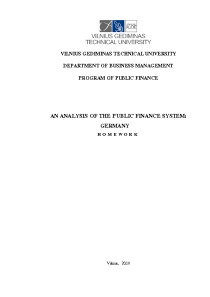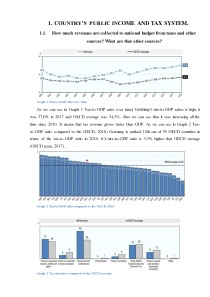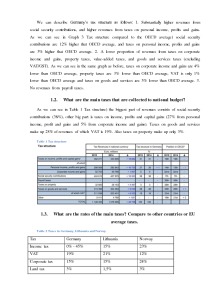Germany Public Finance System



Country’s public income and tax system. How much revenues are collected to national budget from taxes and other sources. What are the main taxes that are collected to national budget? What are the rates of the main taxes? Compare to other countries or EU average taxes. What is the size of country’s “Black” economy? How it affects national income? Country’s public spending and national budget. What is the size of national budget? National government spending, municipalities spending, EU impact. The structure of national budget and public spending – how money is distributed between different areas and public needs. /. Is countries’ public budget balanced? Please give data of several years, how it changes? Does budget balance and debt meet Maastricht criteria?
How much revenues are collected to national budget from taxes and other sources? What are that other sources?
As we can see in Graph 1 (Tax-to-GDP ratio over time) Germany’s tax-to-GDP ratios is high, it was 37,6% in 2017 and OECD average was 34,3%. Also we can see that it was increasing all the time since 2010. It means that tax revenue grows faster than GDP. As we can see in Graph 2 (Tax-to-GDP ratio compared to the OECD, 2016) Germany is ranked 12th out of 35 OECD countries in terms of the tax-to-GDP ratio in 2016. It’s tax-to-GDP ratio is 3,3% higher that OECD average (OECD team, 2017).
We can describe Germany’s tax structure as follows: 1. Substantially higher revenues from social security contributions, and higher revenues from taxes on personal income, profits and gains. As we can see in Graph 3 (Tax structure compared to the OECD average) social security contributions are 12% higher that OECD average, and taxes on personal income, profits and gains are 3% higher that OECD average. 2. A lower proportion of revenues from taxes on corporate income and gains, property taxes, value-added taxes, and goods and services taxes (excluding VAT/GST). As we can see in the same graph as before, taxes on corporate income and gains are 4% lower than OECD average, property taxes are 3% lower than OECD average, VAT is only 1% lower than OECD average and taxes on goods and services are 3% lower than OECD average. 3. No revenues from payroll taxes.
- Economy & Finance Individual works
- Microsoft Word 402 KB
- 2019 m.
- English
- 7 pages (1402 words)
- University
- Silvija

















